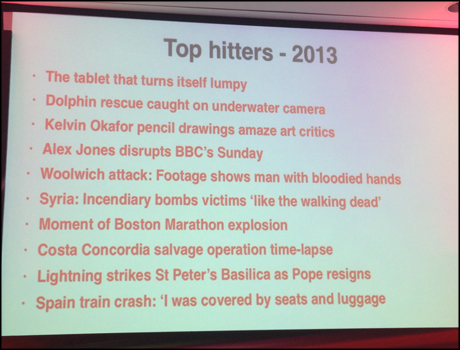The figures were shared by Steve Herrmann, editor of BBC News Online, at the Digital Media Europe conference in London today, to illustrate how important video continues to be.
Despite television's prevailing popularity, online, mobile and social video is growing. Online video traffic on some BBC stories had been "absolutely huge", he said, with "big news stories driving video consumption", but for the top 10 videos from the BBC in 2013, it was not all news.

Although it may seem obvious, he said, "seeing is believing" and the most popular videos were those with a strong visual element where "reading wasn't enough" for the audience.
1. Live stream
For live-streaming, Herrmann said "big news events, unfolding events and events of national or global significance" were the most significant for the BBC.
"It's the sense of being there and watching in real-time," he said, as "seeing it live is very different from catching up later".
Not all publishers will be able to cover such large stories as the BBC, but if it is possible to report on an important event relevant to the audience in real-time, then that will capture the viewers' attention.
2. Raw
'Raw' video is popular for the same reasons as a live-stream, Herrmann said, although not all events will be able to be streamed.
"The key point about raw video is to do with speed," Herrmann said. "Sometimes on digital platforms what counts is getting the video published and visible and you don't necessarily need any extra production."
With an unfolding news story that the audience is already paying attention to "sooner is always better" for video, he said.
3. Immersive - 'live the story'
While packaged television reports need to quickly and efficiently relay the relevant information to the viewer, the audience will reach an online video from a "page" that will put the video in context and give some extra information.
This flexibility lets the BBC create more "immersive" videos for the web, taking the viewer on the journey with a correspondent and letting them "live the story".
Herrmann played a video to delegates in which foreign correspondent Christian Fraser was invited on board a Ukrainian naval vessel in Sevastopol in early March. At the time, Russian forces were blocking the port. Political tensions ran high, an atmosphere that carried into the video.
The television spot and web video were very different in style, but both used the same sequence of footage. The key was in editing it differently for the web, said Herrmann.
This method is successful online because it takes "audiences to where something is actually happening", he said.
Throughout the Crimean report, Christian Fraser narrated the action to take the viewer with him on the journey. This is not always preferable though, said Herrmann.
Another example followed a BBC team who were travelling from the South Sudanese capital, Juba, to Bor, in the oil fields.
The convoy was ambushed and, apart from an introductory text, the first minute and a half shows the "chaos of war", he said, until a piece to camera from a crouched and helmeted correspondent.
4. Show and tell
"Show and tell is even more simple in the idea that the reporter is somewhere and wants to show you something," said Herrmann. "Walk while you talk and show the audience and users and viewers what you're seeing."
The BBC are trying to work "fluidity and movement in to the filming" rather than the "standard, fixed-position piece-to-camera", he said, using this example from Kiev as a key example of the show-and-tell format.
5. Feature
Some video features were made "bespoke for the web", Herrmann said, showcasing one example about a homosexual couple, their adopted son and the child's mother.
The video used graphics and music, "which TV news packages almost never have" Herrmann said, and the piece was so successful on the web that is was used on television.
6. Programme-related
The BBC has also found success in repackaging programme-related material into short web videos.
The first example shown to delegates was the story of "The Man Who Fell To Earth", initially a 40-minute Radio 4 programme repackaged as a seven-minute web video.
The key there, said Herrmann, was in having early conversations "in the commissioning chain to get the right things in the video platform".
These early conversations also played into the Horizon production of "The secret Life of the Cat", in which programme editors decided what footage may be used in different ways at an early stage.
Footage from cameras attached to the cats' collars was used alongside tracking data on where the cats had travelled, to create a new data and multimedia feature with maps, videos and more on the domestic cats followed in the documentary.
7. Explainer
Explainer videos are great for the audience when people need to catch up on an issue, or want some background on a topic, Herrmann said.
The video at the top of this report on Facebook's acquisition of the private messaging app WhatsApp in February uses graphics and text to give viewers a quick overview of the story.
8. Short-form
Elements of the 'explainer' videos informed the BBC's experiments in short-form video, of which the recent Instafax feature, launched in January, is a recent experiment.
"The BBC was used to making 15 second clips for headline sequences," Herrmann said, which facilitated making shorter videos for different uses.
Free daily newsletter
If you like our news and feature articles, you can sign up to receive our free daily (Mon-Fri) email newsletter (mobile friendly).









